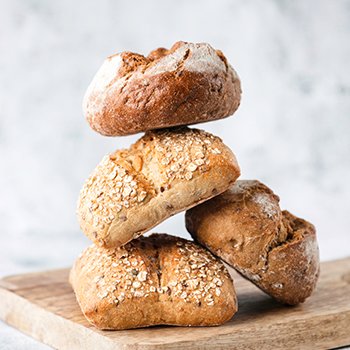ซาวโดวจ์: เทคโนโลยีการผลิตขนมปังเพื่อสุขภาพ Sourdough: Technology for Healthy Bread Production
1883 Views |

ซาวโดวจ์: เทคโนโลยีการผลิตขนมปังเพื่อสุขภาพ
Sourdough: Technology for Healthy Bread Production
By: รศ.ดร. นภัสรพี เหลืองสกุล
Assoc. Prof. Naphatrapi Luangsakul, Ph.D.
Dean, School of Food Industry
King Mongkut's Institute of Technology Ladkrabang
naphatrapi.lu@kmitl.ac.th
หากเอ่ยถึง “ซาวโดวจ์ (sourdough)” สำหรับวงการเบเกอรีในปัจจุบันมักจะนึกถึง sourdough bread หรือขนมปังที่ทำมาจากกล้าเชื้อธรรมชาติ ซึ่งผู้ผลิตจะต้องทำการบ่มหรือเลี้ยงเชื้อในโดวจ์ที่มีแป้งและน้ำเป็นองค์ประกอบหลัก โดยจะต้องให้อาหารกับกล้าเชื้อธรรมชาตินี้อย่างสม่ำเสมอ ในทวีปยุโรปขนมปังที่ใช้กล้าเชื้อธรรมชาติมีมากกว่า 200 ชนิด ซึ่งตัวอย่างขนมปังที่ทุกคนรู้จักกันเป็นอย่างดี เช่น บาแก็ต (baguette) และเซียบัตต้า (ciabatta) เป็นต้น ในขณะที่ขนมของชาวเอเชียที่ผลิตจากกล้าเชื้อธรรมชาติ ได้แก่ ซาลาเปาหน้าแตกและขนมไทยอย่างขนมถ้วยฟู
ชนิดของเชื้อจุลินทรีย์ในซาวโดวจ์
แบคทีเรียกรดแลคติก (LAB) และยีสต์เป็นจุลินทรีย์ 2 ชนิดหลักที่พบในซาวโดวจ์
แต่อาจจะพบจุลินทรีย์กลุ่มอื่นได้ด้วย เช่น แบคทีเรียกรดอะซิติก (acetic acid bacteria) จากการศึกษา พบว่า แบคทีเรียกรดแลคติกที่มักพบในซาวโดวจ์มีจำนวนมากกว่า 50 ชนิด (species) ซึ่งมีทั้ง obligate homofermentative, obligate และ facultative heterofermentative LAB โดยแบคทีเรียกรดแลคติกส่วนใหญ่จะเป็นสายพันธุ์ Lactobacillus แต่อาจจะพบสายพันธุ์อื่นๆ อาทิ Pediococcus, Enterococcus, Lactococcus และ Weisella ได้บ้าง เมื่อแป้งโดวจ์ขยายตัวเต็มที่นั้น (mature dough)ควรมีปริมาณของแบคทีเรียกรดแลคติกอยู่ในช่วง 106-108 cfu/g โดยสัดส่วนระหว่างแบคทีเรียกรดแลคติกกับยีสต์ในระดับเหมาะสมจะมีค่าประมาณ 100: 1 ซึ่งสารสำคัญของซาวโดวจ์ ได้แก่ กรดอินทรีย์ เอนไซม์ และเอ็กโซพอลิแซ็กคาไรด์ (exopolysaccharide) ชนิดต่างๆ จากการผลิตของแบคทีเรียกรดแลคติก
ยีสต์ที่พบในซาวโดวจ์มีจำนวนมากกว่า 30 ชนิด (species) ซึ่งส่วนใหญ่จะอยู่ในกลุ่ม Saccharomyces และ Candida genuses โดยคุณภาพของซาวโดวจ์จากแหล่งผลิตที่แตกต่างกัน จะทำให้เกิดเชื้อจุลินทรีย์ธรรมชาติแตกต่างกัน ซึ่งเป็นสาเหตุให้คุณภาพและประโยชน์ทางด้านสุขภาพของซาวโดวจ์แตกต่างกันไปด้วย โดยปัจจัยสำคัญ ได้แก่ ชนิดของแป้งจากธัญพืชหรือถั่ว ปริมาณน้ำที่ใช้เพื่อทำให้เกิดอัตราส่วนของโดวจ์ที่ได้กับแป้งที่ใช้ (Dough Yield; DY) กระบวนการเลี้ยงเชื้อหรือต่อเชื้อ อุณหภูมิและเวลาในการหมักบ่ม และสภาวะแวดล้อมของกระบวนการหมักบ่ม รวมถึงความทนทานและการปรับตัวของเชื้อจุลินทรีย์ต่อกรด
ประโยชน์ด้านสารอาหารของเทคโนโลยีซาวโดวจ์ต่อร่างกาย
1. เพิ่มคุณสมบัติของสารต้านอนุมูลอิสระ (antioxidant) และลดสารที่ทำลายคุณค่าสารอาหาร (antinutritional)
2. ลดการเปลี่ยนแปลงของระดับน้ำตาลในเลือด (glycemic response) และการตอบสนองของฮอร์โมนอินซูลิน (insulinemic response)
3. เพิ่มฤทธิ์ทางชีวภาพของใยอาหารที่มีอยู่ในแป้ง (bioavailability)
4. เพิ่มวิตามินบางชนิด
5. เพิ่มสารพรีไบโอติกส์ให้กับจุลินทรีย์โพรไบโอติกส์ในลำไส้
Within the context of the modern-day bakery sector, sourdough usually conjures up the image of bread made from sourdough or natural starter culture, which must constantly be fed with culture medium and grown in dough with starch and water as main components. In Europe, more than 200 types of bread are made from natural starter cultures; some well-known examples are baguette and ciabatta. In Asia, snacks made from natural starter culture include, for instance, cha siu bao and Thai rice flour muffins.
Types of Microorganism in Sourdough
Although lactic acid bacteria (LAB) and yeast are the main microorganisms most commonly found in sourdough, other microbial species exist, such as acetic acid bacteria. Research suggests that there are more than 50 species of LAB in sourdough, including obligate homofermentative and obligate and facultative heterofermentative LAB. Most sourdough LAB are Lactobacillus, but also present are some other species such as Pediococcus, Enterococcus, Lactococcus, and Weisella. When a dough is fully mature, the ideal amount of LAB should be 106-108 cfu/g. The adequate LAB/yeast ratio is approximately 100:1. Important substances found in sourdough are, for instance, organic acids, enzymes, and exopolysaccharides, which are produced by LAB.
In sourdough, there are more than 30 yeast species, most of which belong to Saccharomyces and Candida genuses. Different sources of production will yield different qualities of natural microorganisms in sourdough. This is the reason why the qualities and health properties of sourdough vary; main factors include, for instance, type of cereal flour or legume flours, amount of water used to give dough yield (DY), culturing process, temperature and duration of fermentation, environment of fermentation, as well as adaptability and resistance of microbes towards and against acids.
Nutritional and Physiological Benefits of Sourdough Technology
1. Increase in antioxidants and reduction of antinutritional factors
2. Reduction of glycemic response and insulinemic response
3. Increase in bioavailability of fibers in starch
4. Increase in some vitamins
5. Increase in prebiotics for intestinal probiotics






